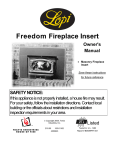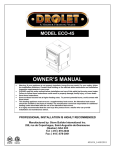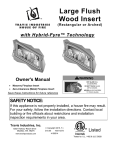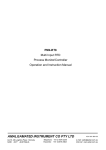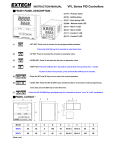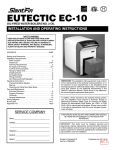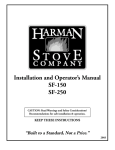Download Waterford Appliances LEPRECHAUN 90 O.S.A User's Manual
Transcript
LEPRECHAUN 90 O.S.A WOODBURNING STOVE SAFETY NOTICE Please read this entire manual before you install and use your new room heater. Failure to follow instructions may result in property damage, bodily injury or even death. This appliance is hot while in operation and retains its heat for a long period of time after use. Children, aged or infirm persons should be supervised at all times and should not be allowed to touch the hot working surfaces while in use or until the appliance has thoroughly cooled. If this stove is not properly installed, a house fire may result. For your safety, follow the installation directions. Contact local building or fire officials about restrictions and installation inspection requirements in your area. The stove must be connected to a UL/ULC listed high temperature residential type H.T. and building heating appliance chimney or an approved masonry chimney with flue liner. INSTALLATION AND OPERATING INSTRUCTIONS TOP FLUE EXIT LEPRECHAUN 90 O.S.A. WOODBURNING STOVE INSTALLATION & OPERATING INSTRUCTIONS GENERAL Fit part no. 14 over top flue aperture in the hob (Part No. 13) make sure that part no. 14 is well secured on a bed of fire cement. The complete installation must be done in accordance with current Standards and Local Codes. It should be noted that the requirements and these publications may be superseded during the life of this manual. Spacer Heat Shield ASSEMBLY OF OPTIONAL CHIMNEY PIPE SHIELD Spacer HEAT SHIELD ASSEMBLY When installing, operating and maintaining your Leprechaun 90 O.S.A. Stove respect basic standards of fire safety. Read these instructions carefully before commencing the installation. Failure to do so may result in damage to persons and property. Consult your local Municipal Office, Fire Department, and your insurance representative to determine what regulations are in force. Save these instructions for future reference. Top Exit: Fit the head shield as follows: Screw the 4” 100mm x 1/4” 6mm tie bolts to the back panel (item 11). Fit the four 1” 25mm spacers (item 31) over the tie bolts. PRE-INSTALLATION ASSEMBLY Step 1: After removing the stove from its packing, open the firedoor door and remove the contents from the fire box. Step 2: Lay the stove on its side and fit the 4 legs (item 1) with the 1/4” (6.4mm) hex sets screws provided, tighten screws. Stand the stove upright, taking care not to strain the leg bolts. Step 3: Install the Hot Plate (item 15) into the large opening of the hob (item 13). Do not remove the Hot Plate when the stove is lighting. Fit the inner heat shield (item 28) with the blanking plate on to the four tie bolts. Now fit the other four 1” 25mm spacers over the tie bolts and fit the outer heat shield (item 30) complete with heat shield blanking plate. Tighten the whole assembly together using the four 1/4” 6mm nuts and washers provided. THIS STOVE MAY BE CONNECTED TO EITHER A TOP OR A REAR VENT. REAR FLUE EXIT Fit back sealing plate (Part no. 17) over the top flue aperture in the hob (Part no. 13). Fit the flue spigot to part no 11 where part no. 17 was, making sure that part no. 17 and part no. 14 are well secured on a bed of fire cement. DAMPER HANDLE ASSEMBLY Leprechaun 90 O.S.A. Fionn 90 OSA 2 Rear Exit: FLOOR PROTECTION Fit the heat shield as follows: When installing this heater on a combustible floor, a floor protector, consisting of a layer of non-combustible material at least 3/8” (9.5mm) thick or 1/4” (6mm) thick covered with 1/8” (3mm) sheet metal is required to cover the area under the heater and to extend to at least 18” (450mm) at the front and 8” (200mm) to the sides and rear. This will provide protection from sparks and embers which may fall out from the door when stoking or fuelling. Screw the four 4” 100mm x 1/4” 6mm tie bolts to the back panel (item 11). Fit the four 1” spacers (item 31) over the tie bolts. Fit the inner heat shield (item 28) without blanking plate onto the four tie bolts. Now fit the other four 1” 25mm spacers over the tie bolts and fit the outer heat shield (item 30) without blanking plate. Tighten the whole assembly together using the four 1/4” 6mm nuts and washers provided. (200mm) (200mm) (450mm) (200mm) (50mm) (50mm) LOCATION There are several conditions to be considered when selecting a location for your Leprechaun 90 O.S.A. a. b. c. d. e. 3 Distance from a suitable chimney (see chimneys). Position in the area to be heated, central locations are usually best. Allowance for proper clearances to combustibles. Obstruction in the ceiling, upper floor or roof, for example, ducting plumbing, electrical fittings and wiring, overhead fixed furnishings, etc. For safety, and to avoid draughts, avoid locations close to an exit. WARNING DO NOT OBSTRUCT FREE AIR SUPPLY TO THE AIR INLET DUCT LOCATED AT THE BACK OF THE STOVE. g. h. l. Air inlets traversing cavity walls should include a continuous duct across the cavity. The duct should be installed in such a man ner as not to impair the weather resistance of the cavity. Joints between air vents and outside walls should be sealed to prevent ingress of mois ture. This stove is listed for Mobile home installa tion provided it is properly connected to an outside air supply and a listed chimney with a ceiling support and spark arrester. DO NOT CONNECT TO OR USE IN CONJUNCTION WITH ANYAIR DISTRIBUTION DUCTWORK UNLESS SPECIFICALLY APPROVED FOR SUCH INSTALLATIONS. OUTSIDE AIR CONNECTION This stove may be connected direct to the outside of the house for its combustion air supply. MOBILE HOME INSTALLATION Note: It is recommended to use the shortest possible outside air supply ducts. Supply ducts with long runs, multi bends and corners may reduce air volume supply due to excessive drag. In addition to standard installation instructions the following requirements are mandatory for installation in a Mobile Home. CAUTION: Do not obstruct combustion air opening. 1. 2. When connecting this stove to an outside air supply the optional outside air kit must be used, which includes a spigot, wire mesh, and fixing screws. a. b. c. d. e. f. 3. 4. Fit the cast iron spigot into the air inlet (Part No. 39). Connect a 4” (100mm) stainless steel, gal vanised ridge or flexible pipe to the air inlet spigot. Fit a 4” (100mm) stainless steel or galvanised sweep bend to the outside of the air supply pipe. Fit the stainless mesh to the downturn of the bend terminus using the fixing screws sup plied with the outside air kit. Make sure that all joints are secured using the fixing screws supplied with the outside air kit. The outside air terminus must be fitted with the 1/4” (6mm) x 1/4” (6mm) stainless wire mesh to prevent leaves and rodents entering from the out side. 5. 6. 4 The stove must be permanently bolted to the floor of the Mobile Home using the floor screws provided. The stove must have a permanent outside air source for combustion. The stove must be grounded to the steel chassis of the Mobile Home. A listed chimney system, roof thimble, spark arrestor and roof flashing kit suitable for use in Mobile Homes must be used. If the chimney exits the Mobile Home at a location other than through the roof, and exits at a point 7ft. (2100mm) or less above the ground level on which the Mobile Home is positioned, a guard or method of enclosing the chimney shall be fitted at the point of exit for a height up to 7 ft.(2100mm). The chimney shall be attached directly to the room heater and shall extend at least 3 ft. (910mm) above the part of the roof through which it passes. The top of the chimney should project at least 2 ft. (610mm) above the highest elevation of any part of the Mobile Home within 10 ft. (3050mm) of the chimney. 7. 8. WALL PROTECTORS The chimney system shall comply with the standard for Chimney’s Factory-Built Residential Type and Building Heating Appliances UL 103. Any openings in a chimney guard if used must not permit the entrance of a 3/4” (19mm) diameter rod. 9. CAUTION: THE STRUCTURAL INTEGRI TY OF THE MOBILE HOME ROOF, FLOOR, WALLS AND CEILING MUST BE MAINTAINED. 10. Check any other local building code as other local codes may apply. 11. WARNING: DO NOT INSTALL IN A SLEEPING ROOM Note: Listed factory built chimney connectors including elbows are acceptable for use in Mobile Home Installation’s. Materials and products listed for the purpose of reducing clearance to combustibles shall be installed in accordance with the conditions of the listing and the clearances may be reduced by the percentage reduction as stated in the wall shield manufacturer’s instructions. For clearance reduction systems using an air space between the combustible wall and the wall protector, adequate air circulation shall be provided by one of the following methods. 5 1. Adequate air circulation may be provided by leaving all edges of the wall protector open with at least a 1” 25mm air gap. 2. If the wall protector is mounted on a single flat wall away from corners, adequate air circulation may be provided by leaving bottom and top edges open with at least a 1” 25mm air gap. 3. Wall protectors that cover two walls in a corner shall be open at the bottom and top edges with at least a 1” 25mm air gap. 4. Chimney, installed in accordance with the manufacturers instructions or a lined masonry chimney acceptable to the authority having jurisdiction. All clearances shall be measured from the outer surface of the combustible material to the nearest point on the surface of the Leprechaun 90 O.S.A., disregarding any intervening protection applied to the combustible material. CHIMNEY CONNECTORS THE CHIMNEY CONNECTOR is a smokepipe used to connect the Leprechaun 90 O.S.A. Stove to the approved chimney described above. The CHIMNEY CONNECTOR must be made of CORROSION RESISTANT STEEL 24 gauge or heavier (“black” or “blued”, or equivalent treated steel). When using a manufactured wall shield system observe local building codes and by-laws. CHIMNEYS Consult the LOCAL BUILDING CODE in all cases as to the particular requirements concerning the installation of SOLID FUEL TYPE ROOM HEATERS. This Leprechaun 90 O.S.A. WOOD BURNING STOVE is intended to be installed in accordance with National Fire Protection Associations Standard for Chimneys, Fireplaces and Vents. NFPA 211-1977. Be sure too fasten the chimney connectors together and also to the flue outlet of the stove through the holes provided. Use at least two screws for each joint. Be sure the joints are tight and fully secured. Chimney connectors shall not pass through an attic, or roof space, closet or similar concealed space, or a floor or ceiling. Where passage through a wall, or partition of combustible construction is desired, the installation shall conform to CAN/CSA -B 365, Installation code for Solid Fuel Burning Appliances and Equipment. The chimney must have a CROSS SECTIONAL AREA of at least 193.5 sq. cm. (30 sq. inches). It is best connected to a chimney of the same size, as connection to a larger size may result in somewhat less draught. The Leprechaun 90 O.S.A. is a Radiant Room Heater and must be connected to a chimney of the proper size and type, capable of providing an adequate continuous draught of 0.06wg minimum. It is best to connect to a chimney of the same size as the stove spigot. DO NOT CONNECT TO A CHIMNEY SERVING ANOTHER APPLIANCE. Connectors should maintain a pitch or rise of at least 1/4” (6mm) to the foot from the stove to the chimney. It should be installed so as to avoid sharp turns or other construction features that would create excessive resistance to the flow of flue gases. It should be securely supported with joints fastened with sheetmetal screws, rivets, or other approved means. The entire length of a connector should be readily accessible for inspection, cleaning and replacement. Minimum chimney height is 14’ 10” (4.5m) from floor on which stove is installed. An existing masonry chimney should be inspected, and if necessary, repaired by a competent mason or relined, using an approved relining system. The stove must be connected to a chimney with a minimum continuous draught of 0.06”wg. Poor draught conditions will result in poor performance. The connector may pass through walls or partitions constructed of combustible materials provided the connector is either listed for wall pass-through or is routed through a device listed for a wall passthrough and is installed in accordance with the conditions of the listing. Any unexposed metal that is used as part of a wall pass-through system and is exposed to flue gases shall be constructed of stainless steel or other equivalent material that will resist corrosion, softening or cracking from flue gas at temperatures up to 982 oC. Note: Connection to type “B” Gas Vents, approved for connection to a certain gas burning appliance will only result in a fire. CHIMNEY TYPES - USA ONLY CONNECTING TO MASONRY CHIMNEY The stove must be connected to a UL 103 Listed residential Type HT and Building Heating, Appliance chimney installed in accordance with the manufacturers instructions or a masonry chimney constructed in accordance with NFPA 211 Chimney vents and Solid Fuel Burning Appliances. The connector to a masonry chimney must extend through the wall to the liner face or liner but not beyond, and must be firmly cemented to masonry. The connector may pass through walls or partitions constructed of combustible material to a masonry chimney provided the connector system selected is installed in accordance with the proper clearances and conditions (See figures A,B,C,D page 8 & 9). CHIMNEY TYPES - CANADA ONLY The stove must be connected to an Underwriters Laboratories of Canada labelled Factory Built 650oC 6 1. 2. 3. 4. 5. 6. 7. 8. 9. 10. 11. 12. 13. 14. 15. 16. 17. 18. 19. 20. 21. 22. 23. 24. 25. 26. 27. 28. 29. 30. 31. 32. 33. 34. 35. 36. 37. 38. 39. 40. 41. 42. 43. 44. Leg Ashtray Base Base Heat Shield Combustion Chamber Base Plate Fire Door Side Panels Inside Fire Door Door Latch Top Side of Top Baffle Back Panel Back Baffle Hob Spigot Hotplate Front Frame Back Sealing Plate Back Sealing Plate Gasket Door Catch Window Sealing Tape Window Glass Fire Fence Front Side Brick (2) Rear Side Brick (2) Bottom Bricks Lower Side of Top Baffle Air Baffle Inside Back Heat Shield Door Sealing Rope Outside Back Heat Shield Spacers Optional Pipe Shield Heat Shield Blanking Plate Tie Bolts Top Baffle Plate Gasket Back Panel Gasket Side Panel Gaskets Back Baffle Gasket Primary & Secondary Air Spigot Primary and Secondary Air Flap Cast Iron Spacer Connecting Rod Primary Air Control Lever Primary & Secondary Air Spigot Flange LEPRECHAUN 90 O.S.A. WOOD BURNING STOVE EXPLODED VIEW U.S. ENVIRONMENTAL PROTECTION AGENCY Certified to Comply with July 1990 Particulate Emission Standards Maximum Heat Output up to 33,000 BTU’s/hr Heat Output Range 9,000 - 26,700 BTU’s/hr 44 7 THIMBLES 2. Thimbles for chimneys or vent connectors should be of fire clay (ASTM C 315, specifications for Clay Flue Linings), galvanised steel of minimum thickness of 24 gauge, or material of equivalent durability. Thimbles should be installed without damage at the liner. The thimble should extend through the wall to, but not beyond, the inner face of the liner and should be firmly cemented to masonry. Thimbles should be located to provide adequate pitch or rise of chimney or vent connectors and, where the ceiling above the appliance is constructed of combustible material, the location of the thimble should provide minimum clearance required for the connector as specified in section under Minimum Clearances. Minimum chimney clearance from masonry to sheet steel supports and combustibles 2” (50mm) (230mm) Masonry chimney constructed to NFPA 211 Factory built chimney length Air space 9” (230mm) minimum 3. CHIMNEY CONNECTOR SYSTEMS, THIMBLES, AND CLEARANCES FROM COMBUSTIBLE WALLS Minimum 3 1/2” (90mm) thick brick masonry wall framed into combustible wall with a min. of 12” (305mm) brick separation from clay liner to combustibles. Fire clay liner (ASTM C315 or equivalent) min. 5/8” (16mm) wall thickness, should run from outer surface of brick wall to, but not beyond, the inner surface of chimney flue liner and should be firmly cemented in place. FIGURE B Sheet steel chimney connector, min. 24 gauge in thickness, with a ventilated thimble, min. 24 gauge in thickness, having two 1” (25mm) air channels, separated from combustibles by a min. of 6” (150mm) of glass fibre insulation. Opening should be covered and thimble supported with a sheet steel support, min. 24 gauge in thickness. Supports should be securely fastened to wall surfaces on all sides and should be sized to fit and hold chimney section. Fasteners used to secure chimney sections should not penetrate chimney flue liner. Minimum chimney clearance to sheet steel supports and combustibles 2” (50mm) Two air channels each 1” (25mm) Chimney connector Minimum 6” (150mm) glass fibre insulation Minimum chimney clearance to brick and combustibles 2” (50mm) Sheet steel supports Minimum clearance 12” (300mm) of brick Fire Clay Liner 4. Chimney connector Minimum 12” (300mm) to combustibles FIGURE A Non-soluable refractory cement Chimney length flush with inside of flue Insulation material used as part of wall pass-through system should be of non-combustible material and should have a thermal conductivity of 1.0 Btu. in./ft.F (4.88 kg.cal/hr.m.c) or less. All clearances and thicknesses are minimums; larger clearances and thicknesses are acceptable. Any material used to close up the opening for the connector should be of noncombustible material. A connector to a masonry chimney, except for System 2 (under heading Chimney Connector System, Thimbles and Clearances), shall extend to piece through the wall pass-through system and the chimney wall to the inner face of the flue liner, but not beyond. 1. Solid insulated listed factory-built chimney length of the same inside diameter as the chimney connector and having 1” (25mm) or more of insulation with a min. 9” (230mm) air space between the outer wall of the chimney length and combustibles. The inner end of the chimney length shall be flush with the inside of the masonry chimney flue and shall be sealed to the flue and to the brick masonry penetration with non water-soluble refractory cement. Supports should be securely fastened to wall supports and the chimney length shall not penetrate the chimney liner. Masonry Chimney constructed to NFPA 211 8 Two ventilated air channels each 1” (25mm) constructed of sheet steel FIGURE C Solid insulated listed factory-built chimney length with an inside diameter 2” (50mm) larger than the chimney connector and having 1” (25mm) or more of insulation, serving as a pass-through for a single wall sheet steel chimney connector of min. 24 gauge thickness, with a min. 2” (50mm) air space between the outer wall of chimney section and shall be 12” (305mm). Chimney section concentric with and spaced 1” (25mm) away from connector by means of sheet steel support plates on both ends of chimney section. Opening shall be covered and chimney section supported on both sides with sheet steel supports of min. 24 gauge thickness. other listed chimney connector from the appliances flue outlet up through the fireplace damper and smoke chamber, terminating at the first flue tile, or by installing a stainless steel or other listed relining system from the flue outlet up the entire length of the chimney, where necessary. Supports should be securely fastened to wall surfaces on all sides and shall be sized to fit and hold chimney section. Fasteners used to secure chimney sections should not penetrate chimney flue liner. Minimum chimney clearance to sheet steel supports and combustibles 2” (50mm) Chimney Section Minimum clearances 2” (50mm) 1” (25mm) air space to chimney length Air Space 2” (50mm) In Canada when connecting to a masonry fire place the steel chimney connector must terminate at the top of the chimney or flue liner. Chimney length FIGURE D MASONRY FIRE PLACE The stove maybe installed on the hearth extension of a masonry fireplace. In Canada a continuous liner must be provided from the flue collar of the stove to the top of the chimney. In the USA a continuous chimney flue is required. A minimum clearance of 25” (635mm) is required to combustible mantle and a minimum clearance of 14” (355mm) to side trim, which extends less than 2” (50mm) from the face of the fireplace. (See Section under Minimum Clearances to Combustibles). Flue Liner Stainless Steel Chimney Connector Insulated non-combustible throat seal Before the installation the entire fireplace system should be inspected for condition and code compliance prior to connecting to the fireplace chimney. Older fireplaces and chimneys may not have been constructed to current-day codes. VENTILATION & COMBUSTION AIR REQUIREMENTS The fireplace and chimney should be in, or brought up to, acceptable conditions and proper clearances should be met before connecting to the fireplace chimney. Ventilation and an adequate air supply is necessary to supply combustion air to the appliance. Refer to your local Authority for current requirements in your jurisdiction. The size of the flue must be considered. If the fireplace chimney is too large, a relining system may be installed using an approved relining system. Outside combustion air may be required if: The solid-fuel-fired appliance does not draw steadily, smoke rollout occurs, fuels burns poorly, or back drafts occur whether or not there is combustion present. Connection to a masonry chimney may be done by breaching into the chimney from the front of the fireplace, no less than 8” (200mm) above the bottom of the first flue tile, by installing a stainless steel or 9 2. 3. 4. 5. 6. Existing fuel-fired equipment in the house, such as fireplaces or other heating appliances, smell, do not operate properly, suffer smoke roll-out when opened, or back-draft whether or not there is combustion present. Opening a window slightly on a calm (windless) day alleviates any of the above symptoms. The house is equipped with a well-sealed vapour barrier and tight fitting windows and/or has any powered devices that exhaust house air. (e.g. Extraction Hood or Tumble Dryers etc..) There is excessive condensation on windows in the winter. A ventilation system is installed in the house. 2. 3. If these or other indications suggest that infiltration air is inadequate, additional combustion air should be provided from the outdoors. Outside combustion air can be provided to the appliance by the following means: 1. 2. 3. 4. 5. Direct connection: Refer to O.S.A. Hook-up in this manual. Indirect method: for an appliance not certified for direct connection of outside combustion air, the outside air is ducted to a point no closer than (12”) 300mm from the appliance, to void affecting the performance of the appliance. A mechanical ventilation system: if the house has a ventilation system (air change or heat recovery): a. The ventilation system may be able to provide sufficient combustion make-up air for the solid-fuel-fired appliance. b. The householder should be informed that the ventilation system might need to be re-balanced by a ventilation technician after installation of the appliance. 6. 7. SPILLAGE TEST 1. 2. 3. 4. Light/burn appliance under normal conditions in accordance with this installation manual. Close all doors and windows. Operate all appliances requiring a full rate (eg. extraction hoods, tumble dryers etc). Check for spillage. The chimney connector and chimney should be inspected at least twice monthly during the heating season to determine if a creosote build-up has occurred. If creosote has accumulated it should be removed to reduce the risk of a chimney fire. LIGHTING 1. has caught fire adjust the primary air settings to suit the heat requirements. The logs will burn slowly towards the rear of the fire chamber and the rate of burning is adjustable at all times by means of the primary air settings. The more air (wider open ing) the faster the burning. Do not overfire the stove. If the stove or chimney connector glows, you are overfiring the stove. When the fire is reduced to embers, open the door and carefully rake the embers towards the front of the fire chamber and reload with logs. After fuelling the stove hold the fire door (part number 6) cracked open for 3-5 minutes to enhance combustion, close the fire door (item 6) and adjust the Primary air settings to give the required heat output. Keep all combustible materials at least three feet away from the stove and connector pipes. Never dry clothing on or over the stove or within three feet of it. Use the main top of the stove for boiling, simmering etc. You will soon learn the best ways and means of using the stove in order to attain maximum efficiency. Disposal of Ashes - Ashes should be placed in a metal container with a tight fitting lid. The closed container of ashes should be placed on a non-combustible floor or on the ground, well away from all combustible materials, pending final disposal. If the ashes are disposed of by burial in soil or otherwise locally dispersed, there should be retained in the closed container until all cinders have thoroughly cooled. Creosote - Formation and Need for Removal when wood is burned slowly, it pro duces tar and other organic vapours, which combine with expelled moisture to form creosote. The creosote vapours condense in the relatively cool chimney flue of a slowburning fire. As a result, creosote residue accumulates on the flue lining. When ignited this creosote makes an extremely hot fire. Inspect the chimney connector frequently. Tap the connector with your finger when the pipe is cool. If you hear a dull echo, the pipe may need cleaning. Disassemble the chimney connector and clean the sections. Replace corroded pipe sections. The fitting of a slip-joint in the stove pipe makes the dismantling easy for cleaning and inspection of chimney and stove. Lay a few crumpled sheets of paper on the hearth, then a few small sticks or kindling to get the fire started. Open the fire door and light paper. Close the door and open the primary air control ALL THE WAY. The fire will catch the kindling quickly, after which a full size log may be placed on top. After the log 10 MAINTENANCE When inspecting a masonry chimney, start at the cleanout door, normally found in the basement, at the base of the chimney, or on the outside. If your chimney does not have a clean-out door it must be inspected and cleaned by removing stove from chimney. WARNING: DO NOT CLEAN STOVE WHEN HOT. GLASS 1. How to Clean: The glass will clean itself when there is sufficient heat generated by burning fuel. The Air Way system provides pre-heated warm air which keeps the glass clean. IMPORTANT: NEVER LEAVE THE STOVE UNATTENDED WHEN THE FIREDOOR IS IN THE CRACKED OPEN POSITION. UNDER NO CIRCUMSTANCES SHOULD ANY FLAMMABLE LIQUIDS, KEROSENE, GAS OIL LINE, NAPHTHA, ENGINE OIL, LIGHTER FLUID OR CHARCOAL - STARTERS BE USED TO LIGHT OR “FRESHEN UP” THE FIRE. NEVER USE MANUFACTURED LOGS. KEEP ALL SUCH LIQUIDS WELL AWAY FROM STOVE WHILE IN USE WARNING: DO NOT OPERATE THE STOVE WITH BROKEN GLASS. 2. (a) How to Replace: Open the door (item 6) and remove the 4 1/4” (6.4mm) counter sunk screws from the inside Fire Door (item 8) and lift it away. Remove the broken glass and gasket, take the replacement glass and fit gasket. DO NOT USE GRATE OR ELEVATE FIRE - BUILD WOOD FIRE DIRECTLY ON HEARTH. (b) DO NOT BURN GARBAGE/RUBBISH IN THIS UNIT. NOTE: If the gasket is damaged, use a new gasket PRIMARY AIR SETTINGS DOOR ASSEMBLY MAXIMUM - Pull control lever (item 43) all the way towards the front. LOW (MIN) - Push the control lever (item 43) all the way towards the back. (c) (d) Replace the glass and fit the Inside Fire Door (item 8). Tighten the 4 fixing screws. Close the door to make sure that it is sealing properly against the Front Frame (item 16). VITREOUS ENAMEL CLEANING General cleaning must be carried out when the stove is cool. FUNCTION DIAGRAM OF LEPRECHAUN 90 O.S.A. WOOD BURNING STOVE If this stove is finished in a high gloss vitreous enamel, to keep the enamel in the best condition observe the following tips: 1. 2. 3. 11 Wipe over daily with a soapy damp cloth, followed by a polish with a clean dry duster. For stubborn deposits a soap impregnated pad can be carefully used on the vitreous enamel. DO NOT USE ABRASIVE PADS OR OVEN CLEANSERS CONTAINING CITRIC ACID ON ENAMELLED SURFACES. ENSURE THAT THE CLEANSER MANUFACTUR ERS INSTRUCTIONS ARE ADHERED TO. WARNING: USE ONLY CERAMIC GLASS 5mm THICK. ABUSE SUCH AS STRIKING, SLAMMING AND USE OF SUBSTITUTE MATERIALS SHOULD BE AVOIDED. 3. 4. IN THE EVENT OF A CHIMNEY FIRE FIRE SAFETY (a) (b) (c) (d) To provide reasonable fire safety, the following should be given serious consideration: 1. 2. A practiced evacuation plan. A plan to deal with a chimney fire as follows: The installation of smoke detectors. A conveniently located Class A fire extinguisher to contend with small fires resulting from burning embers. Notify the fire department. Prepare occupants for immediate evacuation Close all openings into the stove. While awaiting fire department watch for ignition to adjacent combustibles from over heated stove pipe or hot embers or sparks from the chimney. LEPRECHAUN 90 O.S.A. MINIMUM CLEARANCES TO COMBUSTIBLE MATERIALS: SIDE WALL TO STOVE . . . . . . . . . . . . . . . . . . . . . . . . . . . . . . .20 INCHES - 510 mm BACK WALL TO CHIMNEY CONNECTOR .................................18 INCHES - 460mm BACK WALL TO STOVE TOP & REAR EXIT ..............................141/2” INCHES - 370mm CEILING TO HORIZONTAL CONNECTOR .................................18 INCHES - 460mm CORNER. .....................................................................................13 INCHES - 330mm MANTLE CLEARANCE . . . . . . . . . . . . . . . . . . . . . . . . . . . . . . . .25 INCHES - 635mm SIDE TRIM ...................................................................................14 INCHES - 355mm FLOOR PROTECTION When installing this heater on a combustible floor, a floor protector consisting of a layer of non-combustible material at least 3/8” thick or 1/4” thick covered with 1/8” sheet of metal is required to cover the area under the heater to extend at least 18” at the front and 8” to the sides and back of stove. This will provide protection from sparks and ember which may fall out from the door when stoking or refuelling. Waterford Stanley Ltd., Bilberry, Waterford, Ireland. Tel: 051-302300 Fax: 051-302375 12 Rev: 001: DP030814













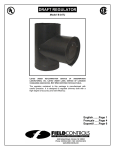
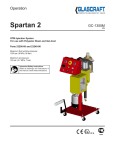
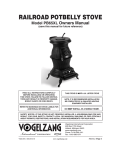
![installation & directions for use installation & mode d`emploi [ en ] [ fr ]](http://vs1.manualzilla.com/store/data/006516414_1-826c39eefa343060f035675bc430e123-150x150.png)
